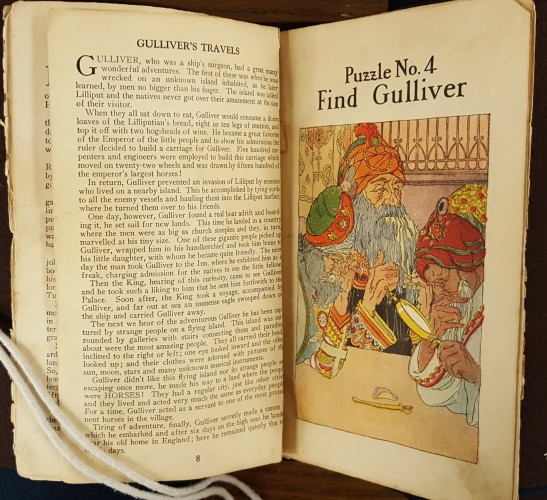Today we celebrate the final day of Picture Book Month and also the 349th birthday of Jonathan Swift, English satirist and poet, most famous for his authorship of Gulliver’s Travels, or to give its full and original name: Travels into Several Remote Nations of the World. In four Parts. By Lemuel Gulliver, First a Surgeon, and then a Captain of Several Ships (1726). In honor of both, this post highlights two picture book editions for children from the Hubbard Collection of Imaginary Voyages.
Satirizing the genre of traveler’s narratives, the politics of his time, and aspects Enlightenment philosophy, Swift’s novel recounts Lemuel Gulliver’s shipwrecks and subsequent travels to several imaginary lands - most famously Lilliput (a land of miniature inhabitants), Brobdingnag (a land of giants), Laputa (a floating island whose inhabitants are wholly absorbed in impractical study and experimentation), and the land of the Houyhnhnms, who are sentient horses. While not written with an audience of children in mind, Gulliver’s Travels has often been adapted and rewritten as juvenile literature, frequently with extensive illustrations.
In adaptations for younger readers during the 20th century, the satirical nature of Gulliver’s Travels often takes a back seat to enjoyment of its fantastical content. Lilliput and Brobdingnag are particularly well-represented in such works. There is, after all, enduring appeal in imagining what it would be like to experience the world as a tiny thumb-sized being or as a giant.
Perhaps the shortest rendition of the story held in Special Collections is that which appears in The Children’s Storybook. Sold for twenty-five cents in 1926, this piece of promotional literature for the Northwestern Yeast Company offers one-page abbreviations of twelve classic stories, each accompanied by a picture-puzzle. In this highly-compressed version, Gulliver’s adventures are part of one continuous sea voyage, unpunctuated by periodic returns home, and the details of his departure from each land are left largely unexplained - for example, rather than departing from Lilliput because he has been charged with treason and escaping by way of rival nation Blefuscu, Gulliver simply “found a real boat adrift.” At the end, rather than making a canoe because he has been ordered to leave the land of the Houyhnmnms, this text says that, “tiring of adventure, finally, Gulliver secretly made a canoe.” Other tales abbreviated for this collection include Little Women, Tom Sawyer, Robin Hood, Hiawatha, Black Beauty, Rip Van Winkle, Treasure Island, Robinson Crusoe, Peter Pan, Joan of Arc, and Swiss Family Robinson.

The Children's Story Book (Chicago: Northwestern Yeast Company, 1926). Special Collections Hubbard Imaginary Voyages NC 7 .C5357 1926. Gift of Susan Wineberg.

The Children's Story Book (Chicago: Northwestern Yeast Company, 1926). Special Collections Hubbard Imaginary Voyages NC 7 .C5357 1926. Gift of Susan Wineberg.
A notable aspect of this publication is that Northwestern Yeast Company sold not only yeast for baking, but Yeast Foam Tablets, Yeast Foam Malted Milk, and Animal-Poultry Yeast Foam. Partaking in a particularly odd 1920s health fad, the opening page seeks to persuade readers of the health benefits of consuming yeast without the benefit of baked goods: “Scientific research in recent years...has disclosed the fact that yeast, taken internally, has marvelous powers as a tonic and revitalizing food. Millions of people have proved this beyond any question or doubt.” One of the advertisements at the back of the booklet notes that Yeast Foam Malted milk is sold “for soda fountain and hospital use” as well as for home consumption. Those eager to try out its benefits are invited to “send 50 cents for [an] Introductory Bottle which we will forward postpaid.” For an amusing account of this health fad, readCatherine Price’s articlein the Chemical Heritage Foundation’s online magazine Distillations.

Advertisements for yeast products from The Children's Story Book (Chicago: Northwestern Yeast Company, 1926). Special Collections Hubbard Imaginary Voyages NC 7 .C5357 1926. Gift of Susan Wineberg.
Published about twenty-five years later, Gulliver in Brobdingnag offers a more lavish journey through one specific portion of Gulliver’s Travels - his time in the land of giants. Illustrated by Vojtěch Kubašta, this charming volume displays the artist’s characteristic use of rounded figures and rich colors, as well as his skillful work as a paper-engineer in the pop-up on the final pagespread, which shows an eagle about to carry off the “tiny” box in which Gulliver has been living to drop it (and Gulliver) into the sea.
Kubašta (1914-1992) was an important and prolific Czech illustrator, paper engineer, and graphic designer who illustrated many dozens of titles during his long career, while working under a succession of difficult social and political climates, including Nazi occupation and post-WWII Soviet influence. More than 10 million copies of his pop-ups were sold worldwide. His pop-ups are particularly notable for their skilful use of a slant-cut that allows the pop-up structures to extend beyond the edges of the pages, adding great dramatic flair.

Swift, Jonathan; Vojtěch Kubašta, illustrator. Gulliver in Brobdingnag (London: Bancroft & Co., 2950). Special Collections Children's Literature NC 989 .C92 K83 G85 1950. The William A. Gosling Pop-up and Movable Book Collection. Gift of William A. Gosling.

Swift, Jonathan; Vojtěch Kubašta, illustrator. Gulliver in Brobdingnag (London: Bancroft & Co., 2950). Special Collections Children's Literature NC 989 .C92 K83 G85 1950. The William A. Gosling Pop-up and Movable Book Collection. Gift of William A. Gosling.

Swift, Jonathan; Vojtěch Kubašta, illustrator. Gulliver in Brobdingnag (London: Bancroft & Co., 2950). Special Collections Children's Literature NC 989 .C92 K83 G85 1950. The William A. Gosling Pop-up and Movable Book Collection. Gift of William A. Gosling.